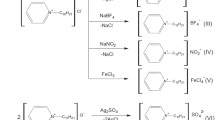Abstract
Several 1-alkoxymethyl-3-substituted-pyridinium chlorides with alkoxy chains including from 3 to 18 carbon atoms were prepared by the reaction of 3-substituted-pyridine with chloromethyl alkyl ethers. The prepared chlorides were examined for their antielectrostatic effects and their antimicrobial activities. 1-Dodecyloxymethyl-3-dimethylaminopyridinium chloride (23) exhibited strong antimicrobial activity and a wide antimicrobial spectrum, similar to the activity of benzalkonium chloride. We synthesized 1-alkoxymethyl-3-hydroxypyridinium chlorides possessing antielectrostatic properties, but lacking antimicrobial activity. The antielectrostatic effect and antimicrobial activities are strongly dependent on the kind of substituent at the 3-position in the pyridine ring and are greatly affected by an alkoxy chain. It was shown that dimethylamino group in position three must be present for a high antielectrostatic and antimicrobial activity of the agent.
Similar content being viewed by others
References
Jones, R.A., Quaternary Ammonium Salts: Their Use in Phase-Transfer Catalysed Reactions, Academic Press, Norwich, 2001, 544 pp.
Kourai, H., H. Takechi, T. Horie, N. Uchiwa, K. Takeichi, and I. Shibasaki, The Antimicrobial Characteristics of Quaternary Ammonium Salts. Part X. Antimicrobial Characteristics and a Mode of Action of N-Alkylpyridinium Iodides Against Escherichia coli, J. Antibact. Antifung. Agents 13:3 (1985).
Pernak, J., L. Michalak, J. Krysiński, and Z. Kuncewicz, Synthesis and Antibiotic Activity of 1-Cycloalkoxymethyl-4-dimethylaminopyridinium and 1-[(1-Alkoxy)ethyl]-4-dimethylaminopyridinium Chlorides, Arch. Pharm. (Weinheim) 328:531 (1995).
Maeda, T., Y. Manabe, M. Yamamoto, M. Yoshida, K. Okazaki, H. Nagamune, and H. Kourai, Synthesis and Antimicrobial Characteristics of Novel Biocides, 4,4′-(1,6-Hexamethylenedioxydicarbonyl)bis(1-alkylpyridinium iodide)s, Chem. Pharm. Bull. 47:1020 (1999).
Pernak, J., J. Rogoża, and I. Mirska, Synthesis and Antimicrobial Activities of New Pyridinium and Benzimidazolium Chlorides, Eur. J. Med. Chem. 36:313 (2001).
Pernak, J., J. Kalewska, H. Ksycińska, and J. Cybulski, Synthesis and Anti-microbial Activities of Some Pyridinium Salts with Alkoxymethyl Hydrophobic Group, Eur. J. Med. Chem. 36:899 (2001).
Khan, K.M., Z. Saify, S. Zeweshan, A. Khan, M. Ahmed, M. Saeed, R.J. Abdel-Jalil, G. Grubler, and W. Voelter, Syntheses of Selected Quaternary Phenacylbromopyridinium Compounds and Their Biological Evaluation, Z. Naturforsch. B: Chem. Sci. 54:1210 (1999).
Welton, T., Room-Temperature Ionic Liquids. Solvents for Synthesis and Catalysis, Chem. Rev. 99:2071 (1999).
Wasserscheid, P., and W. Keim, Ionic Liquids—New “Solutions” for Transition Metal Catalysis, Angew. Chem. Int. Ed. 39:3772 (2000).
Sheldon, K.R., Ionic Liquids for Clean Technology, J. Chem. Tech. Biotechnol. 68:351 (1997).
Sheldon, R. Catalytic Reactions in Ionic Liquids, Chem. Commun.:2399 (2001).
Olivier-Bourbigou, H., and L. Magna, Ionic Liquids: Perspectives for Organic and Catalytic Reactions, J. Mol. Catal. A—Chem. 182–183:419 (2002).
Śliwa, W., N-Substituted Salts of Pyridine and Related Compounds, Częstochowa University Press, Częstochowa, 1996.
Brown, J.S., H.P. Lesutis, D.R. Lamb, D. Bush, K. Chandler, B.L. West, C.L. Liotta, C.A. Eckert, D. Schiraldi, and J.S. Hurley, Supercritical Fluid Separation for Selective Quaternary Ammonium Salt Promoted Esterification of Terephthalic Acid, Ind. Eng. Chem. Res. 38:3622 (1999).
Sipos, G., J.D. Kildea, and G.M. Parkinson, The Role of Quaternary Amines in the Inhibition of Sodium Oxalate Crystal Growth in Bayer Liquor, Ind. Crystallization:1 (1999).
Zhao, W., M. Xia, W. Lei, and F. Wang, Fushi Yu Fanghu 22:332 (2001); cited in Chem. Abs. 136:22695 (2002).
Fox, G.J., J.D. Hepworth, and G. Halls, Bromination of 3-Amino- and 3-Dimethylaminopyridine, J. Chem. Soc. Perkin Trans.:68 (1973).
Pernak, J., A. Czepukowicz, and R. Poźniak, New Ionic Liquids and Their Antielectrostatic Properties, Ind. Eng. Chem. Res. 40:2379 (2001).
Pernak, J., J. Krysiński, and B. Rager, Bakteriostatische Wirkung von 1-(n-Alkoxymethyl)-3-ethylpyridiniumchloriden, Pharmazie 44:578 (1989).
Węglewski, J., J. Pernak, and J. Krysiński, Synthesis and Bactericidal Properties of Pyridinium Chlorides with Alkylthiomethyl and Alkoxymethyl Hydrophobic Groups, J. Pharm. Sci. 80:91 (1991).
Author information
Authors and Affiliations
Corresponding author
About this article
Cite this article
Pernak, J., Branicka, M. The properties of 1-alkoxymethyl-3-hydroxypyridinium and 1-alkoxymethyl-3-dimethylaminopyridinium chlorides. J Surfact Deterg 6, 119–123 (2003). https://doi.org/10.1007/s11743-003-0254-5
Received:
Accepted:
Issue Date:
DOI: https://doi.org/10.1007/s11743-003-0254-5



